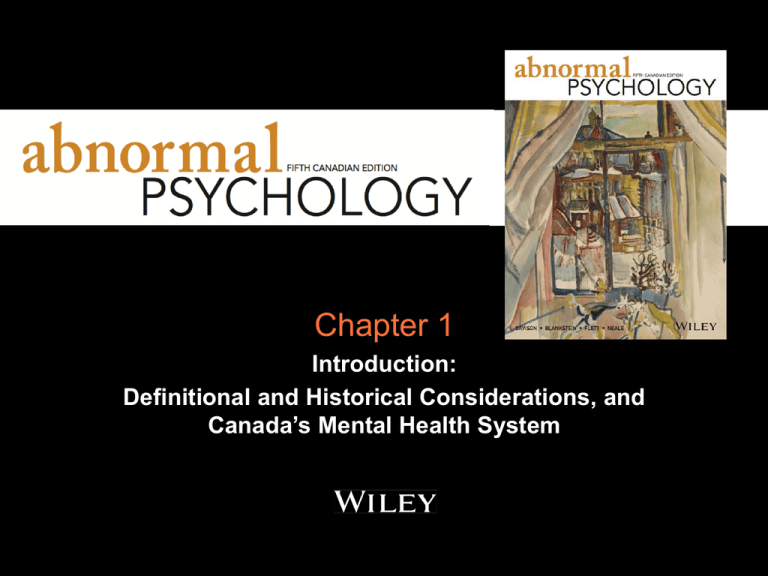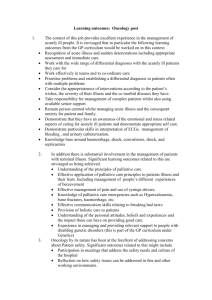
Chapter 1
Introduction:
Definitional and Historical Considerations, and
Canada’s Mental Health System
Psychopathology
•
Is a field concerned with the nature and
development of abnormal…
Behaviour
Thoughts or cognition
Feelings or emotions
•
•
•
The Need For Objectivity
•
When describing and labelling behaviour, there
is a need to be as objective as possible.
This is an interesting time in the study
of abnormal behaviour…
•
•
Research discoveries continue to emerge
in part, fuelled by developments in neuroscience.
•
The field is also under great scrutiny subsequent to
the introduction, in May 2013, of the:
Diagnostic and Statistical Manual–Fifth Edition
(DSM-5; see http://www.dsm5.org).
•
This is an interesting time in the
study of abnormal behaviour…
•
Canada now has its first comprehensive Mental
Health Strategy:
http://strategy.mentalhealthcommission.ca
•
What is abnormal behaviour?
•
Abnormality usually determined by the
presence of several characteristics at one time
such as:
Statistical infrequency
Violation of norms
Personal distress
Disability or dysfunction
Unexpectedness
•
•
•
•
•
Statistical Infrequency
• A behaviour that occurs rarely or infrequently
•
Examples:
•
•
a 14-year old boy wetting his bed
Mental retardation (IQ < 70) or most mental disorders
• Discussion point: Is statistical infrequency a good
enough marker to determine if a behaviour is
abnormal?
•
•
•
Consider elite athletic ability
Consider the flip side of mental retardation-intellectual giftedness (IQ >130)
Violation of Norms
• A behaviour that defies or goes against social
norms; it either threatens or makes anxious those
observing it
•
•
•
This is a definition of abnormal behaviour that is relative to one’s
culture/group
•
What is the norm in one culture may be abnormal in another
Anti-social behaviour of the psychopath violates social norms and is
threatening to others
Discussion point: A prostitute violates social norms
but does this mean that she/he would necessarily
meet diagnostic criteria for a mental disorder?
Personal Distress
• A behaviour that creates personal suffering,
distress, or torment in the person
•
This criterion fits many of the forms of
abnormality such as depression but some
disorders do not necessarily involve distress
•
•
Psychopaths are often not distressed by their
behaviour; however, the behaviour of psychopaths
can impact others in a negative way
Hunger and childbirth cause distress, but is this
abnormal?
Disability or Dysfunction
• A behaviour that causes impairment in some
important area of life, e.g., work, personal
relationships, or recreational activities
•
Examples of exceptions: Being short if you want to be a professional
basketball player. Transvestism is not necessarily a disability; however,
it is currently diagnosed as a mental disorder if it distresses the person
• Discussion point:
Why would transvestism without
distress not be considered a disability?
•
Most transvestites are married, lead conventional lives,
and usually cross-dress in private.
Unexpectedness
•
A surprising or out-of-proportion response to
environmental stressors can be considered
abnormal
For example, we would expect a person to
be sad if they lost a loved one to cancer.
We would not expect a person to laugh after
being sexually assaulted.
Other example: An anxiety disorder is
diagnosed when the anxiety is unexpected
and out of proportion to the situation.
•
•
An Important Note About The Definition
Of Abnormal Behaviour
•
No one definition, by itself, yields a fully satisfactory
definition of abnormal behaviour, but together they
offer a useful framework for beginning to define
abnormality.
The Treatment of Mental Disorders in
Canada (Goering et al., 2000)
•
•
•
•
There are approximately:
•
•
•
3,600 practicing psychiatrists
13,000 psychologists and psychological associates
11,000 nurses specialize in the mental health area
Non-medical practitioners usually work within hospital or
agency settings on a salary or in private practice
Public health plan reimbursement of fees-for-service is
limited to medical doctors
Most of the primary mental health care is delivered by
general practitioners
Canadians Use of Psychologists (NPHS;
Statistics Canada, 1995)
•
It is estimated that approximately 2% of Canadians had
consulted with a psychologist one or more times in the
preceding 12 months (Hunsley, Lee, & Aubry, 1999) in
the Canadian population aged 12 and older.
However, it is thought that psychological services
are vastly underused.
•
Different Mental Health Practitioners
•
•
•
Psychiatrist, psychologist—
what’s the difference?
Clinical psychologists typically have a Ph.D. or Psy.D.
degree, which entails four to seven years of graduate
studies
Psychiatrist hold an MD degree and have had
postgraduate training, in which they receive supervision
in the practice of diagnosing and psychotherapy
Because psychiatrists have an MD degree, they can
prescribe psychoactive drugs, whereas psychologists
can not
•
For more details: “FOCUS ON DISCOVERY 1.1: THE MENTAL
HEALTH PROFESSIONS”
History of Psychopathology
• “Those who cannot remember the past are
condemned to repeat it.”
• George Santayana, The Life of Reason
Pre-scientific Inquiry
• Mental disorders were believed to be caused by:
•
•
•
Events beyond the control of humankind, such as
eclipses, earthquakes, storms, fire, diseases were
regarded as supernatural
Behaviour that seemed outside individual control was
subject to similar interpretation
Thus, many early philosophers, theologians, and
physicians believed that deviant behaviour reflected the
displeasure of the gods or possession by demons
Early Demonology
•
Demonology: The doctrine that an evil being, such
as the devil, may dwell within a person and control
his or her mind and body
•
•
Found in the records of the early Chinese, Egyptians,
Babylonians, and Greeks
Given that abnormal behaviour was caused by
possession, treatment often involved exorcism
•
Ranged from the less extreme (elaborate rites of prayer,
noisemaking, forcing the afflicted to drink terrible-tasting
brews) to the more extreme (flogging and starvation to render
the body uninhabitable to devils).
Trepanning
• Involved the making of a surgical opening
in a
living skull by some instrument
•
Treatment used by Stone Age or Neolithic cave
dwellers
• Used to treat epilepsy, headaches, and
psychological disorders attributed to demons
• Thought to be introduced into the Americas from
Siberia
•
•
Practice was most common in Peru and Bolivia,
Three British-Columbia Aboriginal specimens found
Hippocrates (ca. 460–377 B.C)
• Separated medicine from religion, magic, and
superstition
• Rejected belief that the gods sent physical
diseases and mental disturbances as
punishment
• Insisted that illnesses had natural causes thus
should be treated like other illnesses
Somatogenesis vs. Psychogenesis
•
Hippocrates is one of the earliest proponents of
somatogenesis
•
•
Somatogenesis (genesis = origin)
•
Mental disorders are caused by aberrant
functioning in the soma (i.e., physical body) and
this disturbs thought and action
Psychogenesis
•
Mental disorders have their origin in psychological
malfunctions
Hippocrates’ Mental Classifications
1. Mania
2. Melancholia
3. Phrenitis (or brain fever)
Hippocrates’ Humoral Physiology
• Hippocrates’ treatments were different from
exorcistic tortures
•
Tranquility, proper nutrition, abstinence from sexual
activity were prescribed for melancholia
• Mental health dependent on a delicate balance
among four humours, or fluids, of the body
• Imbalances and results
•
•
•
•
blood = changeable temperament
black bile = melancholia
yellow bile = irritability and anxiousness
phlegm = sluggish and dullness
The Dark Ages and Demonology
•
•
•
Churches gained in influence, papacy was declared
independent of the state
Christian monasteries replaced physicians as
healers and as authorities on mental disorder
The monks cared for and nursed the sick
By praying and touching them with relics
Concocting fantastic potions for them
•
•
•
•
•
•
Persecution of Witches
During the 13th and the following few centuries, major social
unrest and recurrent famines and plagues
People turned to demonology to explain disasters
Led to an obsession with the devil
•
1484 Pope Innocent VIII exhorted European clergy to leave no
stone unturned in the search for witches
•
•
“witches” were blamed and zealously persecuted
Sent two Dominican monks to northern Germany as inquisitors who later
issued the manual entitled the Malleus Maleficarum (“the witches’
hammer”)
•
•
Used to guide witch hunters
Came to be seen by Catholics and Protestants as a textbook on witchcraft
Over the next several centuries, hundreds of thousands of
people accused, tortured, and murdered
Witchcraft and Mental Illness
• Were so-called witches psychotic?
•
•
Detailed examination of historical period indicates
most were not mentally ill
Delusion-like confessions were obtained during
torture
•
In England, where torture was not allowed, the confessions did
not usually contain descriptions indicative of delusions or
hallucinations (Schoeneman, 1977).
•
•
Other information that “witches” were
not mentally ill
From 13th century on in England, hospitals took over churches’
responsibility to tend to the ill
Laws allowed dangerously insane and incompetent to be
confined to hospital
• and people confined were not described as being
possessed
• Early 13 century “lunacy” trials held in England
• Trials conducted to protect the mentally ill
• Judgment of insanity allowed Crown to become guardian of
th
estate
•
•
Defendant’s orientation, memory, intellect, daily life, and habits
were at issue in the trial
Strange behaviour were explained as physical illness / injury
Development of Asylums
•
•
Until the end of the 15th century, very few mental hospitals in
Europe
In the 12th Century, England and Scotland had 220 leprosy
hospitals
Leprosy gradually disappeared from Europe and attention
turned to the mentally ill
•
•
•
Confinement began in earnest in the 15th-16th centuries
Leprosariums were converted to asylums
•
•
•
Asylums took disturbed people and beggars
Had no specific regimen for their inmates but work
Despite the desire to help ‘the mad,’ hospitals tailored for
the confinement of the mentally ill also emerged
St. Mary of Bethlehem
•
Founded in 1243 in London, devoted solely to the
confinement of the mentally ill
•
•
Conditions were deplorable (bedlam - a descriptive
term for a place or scene of wild uproar and confusion)
Eventually became one of London’s great (paid) tourist
attractions
•
•
Viewing the violent patients considered entertainment
Discussion Point: What might be the effects of such
inhuman treatment on the sequela of mental illness?
Did the inclusion of the mentally ill to
hospitals/medicine lead to more humane treatment?
•
•
Medical treatments were often crude and painful.
Benjamin Rush (1745–1813) is considered the
father of American psychiatry.
He believed that mental disorder was caused by
an excess of blood in the brain. Consequently,
his favoured treatment was to draw great
quantities of blood (Farina, 1976)!
•
•
He believed that many “lunatics” could be cured
by being frightened.
Moral Treatment
•
•
•
Philippe Pinel (1745–1826) considered primary figure in movement
for humanitarian treatment of the mentally ill in asylums
Believed patients should be treated with dignity
•
•
•
•
•
Put in charge of a large asylum in Paris known as La Bicêtre
Jean-Baptiste Pussin and then Pinel removed the chains of the
people imprisoned
Began to treat patients as sick rather than as beasts
Light and airy rooms replaced dungeons
Walks around the grounds were allowed
Results?
•
Some patients incarcerated for years were discharged
The York Retreat
•
William Tuke (1732–1822) proposed to the
Society of Friends that it found its own
institution (in contrast to the privately run
institutions of the day).
In 1796 the York Retreat was established
on a country estate, providing mentally ill
people with a quiet and religious
atmosphere in which to live, work, and rest.
•
Institutions In The United States
•
•
The Friends ’ Asylum (1817) in Pennsylvania
and the Hartford Retreat (1824) in Connecticut
were patterned after the York Retreat.
Other U.S. hospitals were influenced by the
sympathetic and attentive treatment provided
by Pinel and Tuke.
Dorothea Dix
•
Moral treatment was abandoned
in the latter part of the 19th
century but Dorothea Dix’s
(1802–77) efforts resurrected it
•
•
•
Boston schoolteacher who taught a
Sunday-school class at the local
prison
Shocked by deplorable conditions
and interest spread to the conditions
of patients in mental hospitals
Campaigned vigorously and
successfully to improve the lives of
people with mental illness
Asylums in Canada
•
•
Network of asylums eventually established in
Canada
Sussman (1998) argued that the development
of services for the mentally ill in Canada and
British North America was largely ad hoc, with
little cross-fertilization of ideas from province to
province.
Asylums in Canada
•
•
•
The earliest precursor to the nineteenthcentury asylums was the Hôtel-Dieu,
established in Quebec City in 1714 by the
Duchess d’Aiguillon
The first asylums in Canada were built during
the institution-building period prior to the First
World War.
Alberta was the last province to open an
asylum for the insane.
Beginning of Contemporary
Thought
•
•
In 19th century, there was a return to the
somatogenic views first espoused by
Hippocrates
Early system of classification established
•
•
Emil Kraepelin (1856–1926)
Created a classification system to establish the biological
nature of mental illnesses
Noticed clustering of symptoms (syndrome) which were
presumed to have an underlying physical cause
•
•
In fact, mental illness is seen as distinct, with own genesis,
symptoms, course, and outcome
Proposed two major groups of severe mental diseases:
• Dementia praecox (early term for schizophrenia)
• Thought chemical imbalance as the cause of schizophrenia
• Manic-depressive psychosis (now called bipolar disorder)
•
•
Thought an irregularity in metabolism as the cause of manicdepressive psychosis
Importantly, Kraepelin’s early classification scheme became the
basis for the present diagnostic categories
General Paresis and Syphilis
• Mid-1800s progress was being made in terms
•
of understanding senile and presenile
psychoses and mental retardation from a
more biological perspective
Far more was then discovered about the
nature and origin of syphilis
•
General paresis characterized by steady
physical and mental deterioration, delusions of
grandeur and progressive paralysis from which
there was no recovery
•
Discovery provides a good example of the increasing
use of empirical approaches used to understand mental
illness
Louis Pasteur
•
Germ theory of disease, established by Pasteur
Laid the groundwork for demonstrating the relation
between syphilis and general paresis
Also helped establish a causal link between
infection, destruction of brain areas, and a form of
psychopathology
A thought:
•
•
•
•
•
If one type of psychopathology had a biological cause,
so could others
Result:
•
Somatogenesis gained credibility and became a
dominant theory
Psychogenesis Re-visited
•
Somatogenic causes dominated field of
abnormal psychology until 20th Century due in
large part to discoveries about general paresis;
however, psychogenesis was still “in fashion” in
countries like France and Austria
Mental Health Care in Canada
•
•
•
•
Canada has had a universal health care system since
1970
Each province/territory is responsible for
administrating health care
Health-care re-organisation and funding cuts have led
to the closing of long-term psychiatric mental hospitals
and beds on psychiatric hospital wards
Community services are expected to take over some
of these services
•
See Canadian Perspectives 1.2 for more details
•
•
Historical Perspective of Mental Health
Care in Canada
The health care system in Canada has not always been
stellar in its ethical treatment of patients under its care
Examples are:
•
•
•
•
Dr. Cameron’s brainwashing treatment in Montreal in the 1950s and
60s
Psychosurgery (e.g., lobotomy) performed out of scientific curiosity,
i.e., to see how it would change patients
In either case, consent was not obtained from patients or families
Lobotomies were effectively banned in all psychiatric
hospitals in early 1980s
•
See Canadian Perspectives 1.3 for more details
Deinstitutionalisation (Sealy, 2012)
• The process of deinstitutionalisation has been
•
•
going on for more than 40 years in Canada.
The goal of deinstitutionalisation was/is to shift
care from psychiatric hospitals into the community.
The process of rapid deinstitutionalisation occurred
in five provinces (Alberta, British Columbia,
Ontario, Nova Scotia, and Saskatchewan).
Deinstitutionalisation (Sealy, 2012)
•
According to Wasylenki, Goering, and
MacNaughton (1994), the capacity of Canadian
mental hospitals went from about 50,000 beds
to about 15,000 beds between 1960 and 1976.
At the same time, beds in general hospital
psychiatric units increased from fewer than
1,000 to almost 6,000.
•
Deinstitutionalisation
•
The enthusiasm for deinstitutionalisation was
tempered by evidence that many discharged
people lead lives of poverty in the community,
with a significant number included among the
homeless and the prison population.
Transinsitutionalisation
•
More care is now provided in psychiatric units
of general hospitals rather than in psychiatric
hospitals.
Transinsitutionalisation
•
•
However…
When considering 2004–05 data, there are
many more mentally ill people in gaols and in
prisons than in hospitals (see Torrey et al.,
2010).
300% more patients with serious mental
illness where incarcerated than in hospitals.
•
Transinsitutionalisation
•
In Canadian Prisons:
Rates of mental illness detected at intake have
doubled between 1997 and 2008.
Overall, 13% of male inmates and 29% of women
inmates have mental health problems at intake.
Estimates indicate that 50% of federally
sentenced women report histories of selfharm, and over half report a current or past
addiction. In addition, 85% report a history of
physical abuse and 68% report a history of
sexual abuse.
•
•
•
The Current Role of
Psychiatric Hospitals
•
A “tertiary” role:
they “provide specialised treatment and
rehabilitation services for individuals whose
needs for care are too complex to be
managed in the community” (Goering et al.,
2000, p. 349).
•
•
Current Trend: Community Treatment
Orders (CTOs)
Community treatment orders (CTOs)
a legal tool issued by a medical practitioner
that establishes the conditions under which
a mentally ill person may live in the
community, including requirements for
compliance with treatment (O ’Reilly, 2004).
The consequence for a patient of failing to
follow the CTO is being returned to a
psychiatric facility for assessment.
•
•
Community Psychology
•
•
Rather than waiting for people to initiate
contact, community psychologists seek out
problems, or even potential problems.
They often focus on prevention , in contrast to
the more usual situation of trying to reduce the
severity or duration of an existing problem.
Stereotyping and Stigmatization
•
People with psychological disorders often face
negative stereotyping and stigmatization .
According to the Centre for Addiction and
Mental Health in Toronto (CAMH, 2000), the
social stigma surrounding depression is the
primary reason why only one third of the
estimated three million people in Canada
who suffer from depression seek help.
•
Self-Stigma
• The tendency to internalise
mental health stigma and see
oneself in more negative terms
as a result of experiencing a
psychological problem.
Misperceptions
•
Many common misconceptions or myths of mental illness
can be dispelled.
For example, it is a common belief that people with
psychological disorders are unstable and dangerous.
Examples such as Vincent Li are incredibly rare
•
•
Image of Vincent Li.
[National Post website.]
Mental Illness and
Violence/Dangerousness
• There is a small but significant relation between
•
schizophrenia and violent acts (see Taylor, 2008, for
review).
A recent major American epidemiological study
(Elbogen & Johnson, 2009) found that the incidence
of violence was higher for people with severe mental
illness; however, the effect was significant only for
those with co-occurring substance abuse or
dependence.
Mental Health Literacy…
•
Is the accurate knowledge that a person
develops about mental illness and its causes
and treatment.
A recent review concluded that more
positive and informed attitudes are found
among younger people, more educated
people, people with training, and those with
personal experience, perhaps due to having
a family member with some form of illness
(Furnham & Telford, 2011).
•
Rates of Mental Illness in Canada
•
Canadian Community Health Survey (CCHS)
was the first comprehensive Canadian
national study to use a full current version of
the Composite International Diagnostic
Interview
large sample size (nearly 37,000
community- dwelling respondents)
•
•
Mental Illness In Canada
•
•
•
•
•
1 out of every 10 Canadians aged 15 and over (about 2.7
million people) reported symptoms consistent with a mood
or anxiety disorder, or alcohol or illicit drug dependence
during the previous 12 months.
1 in 20 met criteria for either major depression or bipolar
disorder.
1 in 20 met criteria for panic disorder, agoraphobia, or
social phobia.
1 in 30 met criteria for substance dependence (alcohol or
illicit drug use).
1 in 50 met criteria for moderate risk of problem gambling.
Mental Illness In Canada:
Gender Issues
•
•
•
Women were 1.5 times more likely than men to
meet criteria for a mood or anxiety disorder
Men were 2.6 times more likely than women to
meet criteria for substance dependence.
Eating attitude problems and agoraphobia were
6 times and 5 times more common among
women than men, respectively.
Mental Illness In Canada: Age Of
Onset Reported
•
•
•
Two-thirds (69%) of young people 15–24 with a
mood or anxiety disorder reported that their
symptoms started prior to age 15.
About half (48%) of people 45–64 and one-third
(34%) of seniors stated that their disorder began
prior to age 25.
Mood and anxiety disorders also developed during
each life stage.
Mental Illness In Canada: Geography
•
•
People in Newfoundland and Labrador and
Prince Edward Island reported the most
happiness and the least distress.
Quebec is noteworthy because it reported very
high levels of self-esteem and mastery but the
least happiness and most distress.
Mental Illness In Canada:
Socioeconomic Status
•
When compared with people with an annual
income of $70,000 or more, people with less
than $19,000 per year were 4.3 times more at
risk of having a diagnosable mental disorder
(Caron et al., 2012).
The Cost Of Mental Illness In Canada
•
The estimated economic burden of serious mental
illness in Canada is substantial.
the burden of mental illness and addictions is 1.5
times greater than the combined burden of all
cancers (Ratnasingham et al., 2012).
Total direct cost in 2003/2004 in Canada was 6.6
billion (Jacobs et al., 2008)
2007–08 data suggested 14.3 billion (Jacobs et al.,
2010).
7.2% of government health expenditures.
•
•
•
•
The Romanow Report
•
•
•
Building on Values: The Future of Health Care in
Canada (2002)
The Romanow Report made 47 recommendations
Romanow called mental health care “the orphan child of
medicare” and recommended to make it a priority
•
Some of the recommendations were:
•
•
•
•
Include some homecare services for case management and intervention
services
Develop a national drug agency
Provide a emergency drug program to help those with severe mental illnesses
(e.g., schizophrenia and bipolar disorder)
Establish a program to support informal caregivers (e.g., friends, families) who
assist the mentally ill in critical times
•
•
•
The Future of Psychology
The Canadian Psychological Association (CPA) was critical of the
Romanow Report as it (1) did not include psychology’s vision and (2)
embraced a ‘physical medicine vision’ or somatogenic perspective
CPA argued that:
•
•
A plethora of research on the improved effectiveness of
pharmacotherapy when combined with psychological treatment
Savings could range as high as 80% of currently dominant treatments,
including medication
The World Health Organization (WHO) and other organizations
advocate for (1) the integration of mental health services into primary
health care and (2) the collaboration of care tams as the way of the
future
The Kirby Report
•
•
Out of the Shadows at Last: Transforming Mental Health,
Mental Illness, and Addiction Services in Canada (The
Senate Committee on Social Affairs, Science and
Technology, 2006)
2 Key recommendations were made:
•
The creation of the Canadian mental health commission
• Facilitate a national approach to mental health issues
• Promote reform of mental health policies and improvement of services
• Educate Canadians by increasing mental health literacy
• Reduce stima and discrimination of mentally ill individuals and families
1. The creation of the 10-year Mental Health Transition Fund
1.
2.
Provide affordable housing to the mentally ill
Offer support to provinces / territories in order to increas services in the community
Delivery Of Treatment: Wait Times & Treatment Needs
•
A 2008 report by The Fraser Institute (Waiting Your Turn: Hospital
Waiting Lists in Canada) noted that the national median wait time for
those seeking psychiatric treatment in 2008 was 18.6 weeks
•
•
Approximately 170% longer than what specialists believe is
appropriate.
Interesting: Extensive evidence indicates that the majority of people
who need help do not seek it.
•
•
Although the strongest predictor of help-seeking was psychiatric
diagnosis, help-seeking was also associated with marital disruption and
poverty.
Females are more willing to seek help than males.
Copyright
•
Copyright © 2014 John Wiley & Sons Canada, Ltd. All rights
reserved. Reproduction or translation of this work beyond that
permitted by Access Copyright (The Canadian Copyright
Licensing Agency) is unlawful. Requests for further information
should be addressed to the Permissions Department, John
Wiley & Sons Canada, Ltd. The purchaser may make back-up
copies for his or her own use only and not for distribution or
resale. The author and the publisher assume no responsibility
for errors, omissions, or damages caused by the use of these
programs or from the use of the information contained herein.





